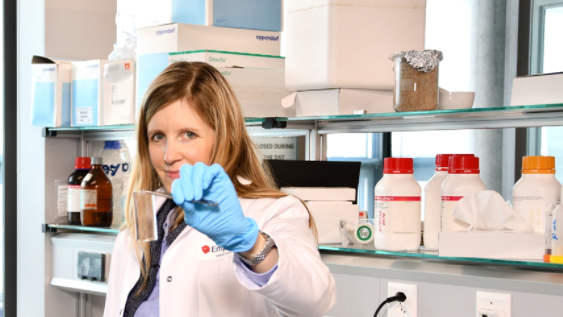Empa - Plasters for internal wounds
Closing wounds in the digestive tract is a challenge. Empa researchers have therefore developed a polymer plaster for the intestine that can be used to stably adhere and seal injuries.

Image: The team led by Inge Herrmann and Alex Anthis has developed a hydrogel plaster that provides a stable seal for surgical wounds, Empa
A ruptured appendix or a life-threatening intestinal stricture are emergencies that must be treated by surgeons as quickly as possible. However, a rescue operation, in which tissue from the digestive tract has to be rejoined, involves a number of risks. After all, everything that is constantly being transported towards the outside world in the gastrointestinal tract actually belongs there - and should never end up inside the abdominal cavity. Corrosive digestive juices and germ-laden food residues could trigger peritonitis or even fatal blood poisoning (sepsis). However, a needle and thread alone are not necessarily the ideal surgical tool for joining two pieces of intestine together - after all, you wouldn't want to sew up a leaking milk carton either. Empa researchers have therefore now developed a plaster that provides a stable seal between two pieces of intestine sewn together, thus preventing dangerous leaks.
Dreaded complications
The idea of sealing sutured tissue in the abdominal cavity with a plaster has already arrived in the operating theater. However, after the first such products proved to be poorly tolerated or even toxic, these plasters are now made from biodegradable proteins. The problem is that clinical success is not always optimal and varies depending on the tissue that is stuck together. This is because the protein patches are primarily intended to support the healing process, but dissolve too quickly on contact with digestive juices and do not always hold tight. "Leakages after abdominal surgery are still one of the most feared complications today," explains Empa researcher Inge Herrmann, who also holds the professorship for Nanoparticular Systems at ETH Zurich.
The team led by Herrmann and Alexandre Anthis from the Particles-Biology Interactions Laboratory at Empa in St. Gallen, together with Andrea Schlegel, a surgeon at Queen Elizabeth University Hospital in Birmingham, therefore searched for a material that would reliably seal intestinal injuries and surgical wounds. They found what they were looking for in a synthetic composite material made from four acrylic substances that form a chemically stable hydrogel. The plaster also actively cross-links with the intestinal tissue until no more fluid can pass through. The researchers have already successfully patented this innovative technology. The quadriga of acrylic acid, acrylic acid methyl ester, acrylamide and N,N′-methylene bisacrylamide works in perfect synergy, as each component contributes to the overall work with a specific property: a stable bond to the mucous membrane, the formation of networks, stability against digestive juices and waterproofness.
Empa in St.Gallen uses the properties of the nano-dwarfs in particular for blood purification (for example, using small magnetic particles with appropriate functionalization to fish toxins, viruses or bacteria out of the blood), for diagnostics or as tissue adhesives (whereby the large surface area of the nanoparticles helps to bind the biological macromolecules and thus close wounds that are difficult to suture). Many other application ideas are in the queue and the St.Gallen location is at the forefront of international nanomedicine thanks to its local expertise.
Tailor-made plasters
In laboratory experiments, the researchers showed that the polymer system meets expectations. "The adhesion is up to ten times higher than with conventional adhesive materials," says Empa researcher Anthis. "Further analyses also showed that our hydrogel can withstand five times the maximum pressure load in the intestine." And the design of the material is the reason for its tailor-made effect: the rubber-like composite reacts selectively with digestive juices that could escape from intestinal wounds, swells and closes all the more tightly. The cost-effective, biocompatible superglue, which consists largely of water, could thus shorten hospital stays and save healthcare costs. Alexandre Anthis is therefore already planning the next steps towards clinical application of the new wound plaster: "We are currently in the process of founding a start-up to bring this innovative material to market maturity."

